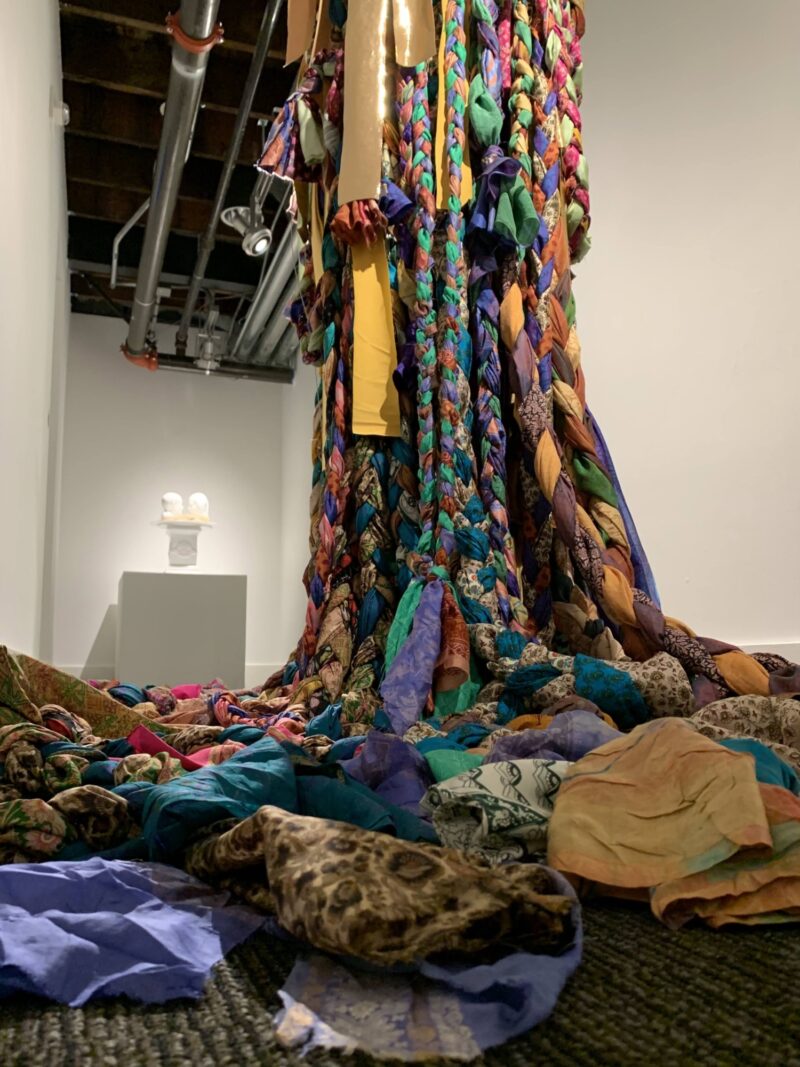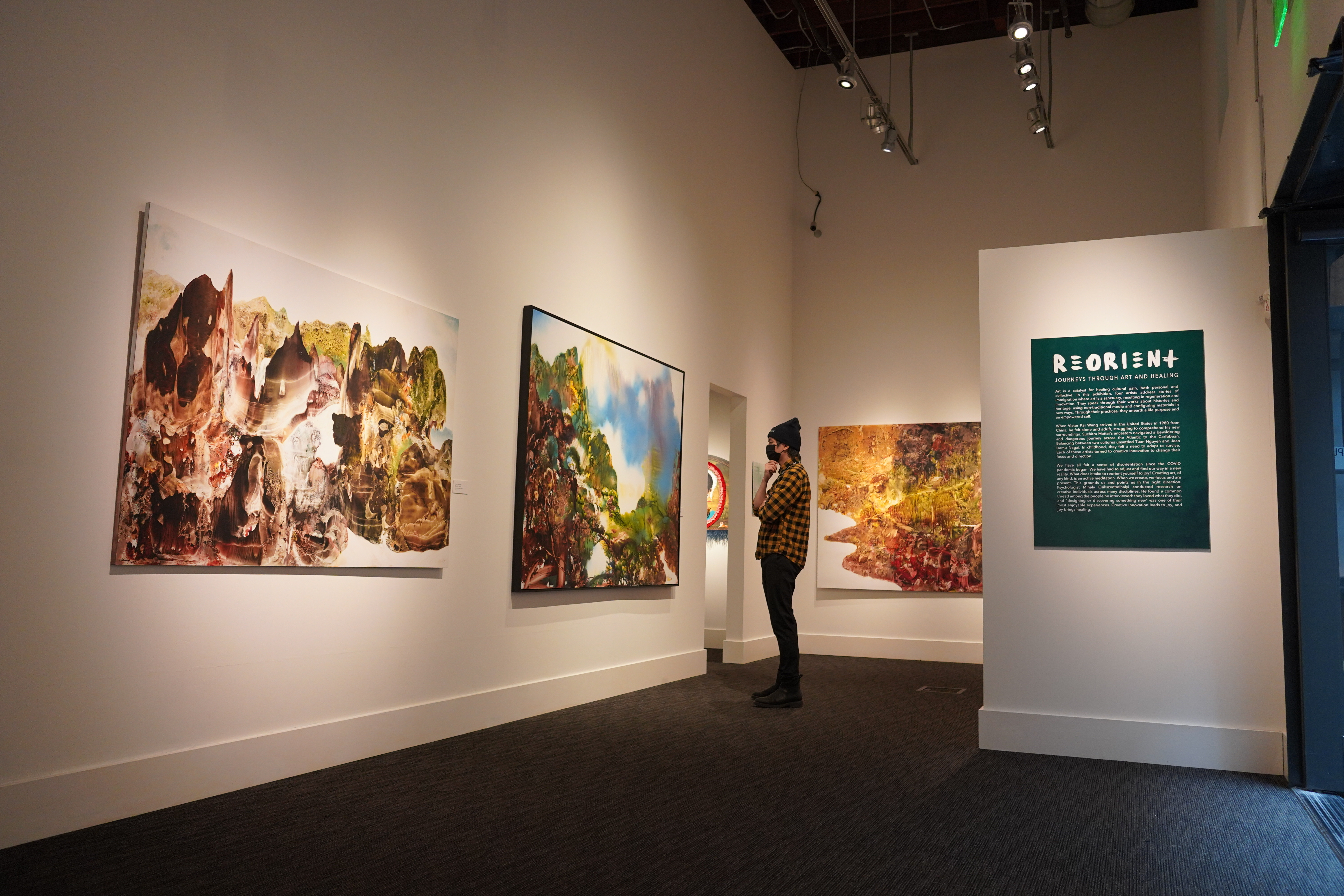"Reorient": Processing Immigration Through Art
Review of Reorient: Journeys Through Art and Healing at the Wing Luke Museum
Written by Teen Writer Harlan Liu and edited by Yoon Lee

The Reorient: Journeys through Art and Healing display at the Wing Luke Museum features four Asian artists who use their different mediums as ways of telling their stories of immigration and finding purpose. These artists are able to express their gratitude, nostalgia, and defiance through dyed fabric, sculptures, ink-wash paintings, using color and unorthodox shapes to suggest the tone or emotion of a work and appeal to audiences.
First entering the exhibit, there is plenty of blank wall space, wherein only after you turn in either direction can you see the paintings of Victor Wang. His style of art holds a strong influence from his time spent working at a photography studio, as most of his pieces were made using pen ink on photographic paper later blended together with solvent, a liquid used to develop photographs. His use of unconventional materials in his paintings reflect his background as a photo color-corrector and almost makes it look like Wang pulled the art out of the canvas.
His paintings range from abstract loops and outlines of flowers to dense mountainscapes with temples and waterfalls. These landscapes are based in the Chinese countryside, and within these inked scenes, particularly Sleeping Giant, you can make out faint outlines of tigers and monks masterfully weaved amongst the trees. Wang also uses the bleed of the pen ink and the pull of gravity to shape mountains and ridges of forests, which would have been difficult to achieve with almost any other art medium. I thoroughly enjoyed his portion of the exhibit, and the earthy tones and intricate details of pieces such as Red Cliff and Colored Mountains could captivate me for hours.

Next, stationed in the corridors between exhibit rooms are pieces by Suchitra Mattai, who, out of the four artists featured, uses the most variety in mediums. She uses sections of vintage saris to create her piece Axis Mundi, “Axis of the World”, a towering pole of braided cloth adorned with blue feathers.
On the opposing wall, Mattai has the busts of two well-known figures, Homer, the author of The Iliad, and Susheela, the wife of a Hindu god intertwined with literal twine shaped in a figure-eight surrounding the two. With this piece, the tone of loving acceptance was almost unmistakable, almost as though the two figures are seeing each other in their entirety without the need to hide anything. It perfectly encapsulates the definition of healing through art, as these two connecting figures from very different cultures greet each other in a calm and curious light. I found Mattai’s sculpture to be both creative in her way of expressing reorientation and ingenious in her way of incorporating different material, such as the infinity-shaped twine, to create a clear and strong statement.
On the other side of the hallway are the last two exhibits by Jean Isamu Nagai and Tuan Nguyen. The pieces from both of these artists are abstract and hard to understand at a first glance, but diving deep into symbolism and reading into the titles of the art is very helpful. For example, The Pain Body by Nguyen, a Vietnamese refugee, is a set of traumatic intergenerational stories told in the form of abstract fusing and cutting of woods, metals, and cloth.
One sculpture from The Pain Body in particular, Kohaku River, named after a river spirit from the Studio Ghibli movie Spirited Away, drew me in with its stitched and bunched linen, with a shadow of graphite actually drawn onto the wall of the museum. The title is a reference to gentrification; as in the movie, the character’s spirit dies after their river is covered in apartment buildings. The level of depth and forethought put into this piece and the overall set is incredible.
There’s also another display called Washed Drawings, which appears to be sculptures of animals made out of badly dried paper. However, upon further inspection, Nguyen elaborates on his idea for the piece by stating that the papers that form the sculptures are actually hundreds upon hundreds of unseen art pieces that he has hidden from the world permanently by washing off the ink. However, without the title or the caption beneath it, I would likely not have known the complexity of the art piece, losing some of the depth.
Finally, the last artist featured in this exhibition is Jean Isamu Nagai, a Japanese-American artist whose style focuses on vibrant palettes of pinks, blues, and oranges, and strays towards Pointillism and symmetry. Similar to Tuan Nguyen’s pieces, all three of Nagai’s works are a bit hard to understand at first glance. He uses correction fluid mixed with more textured mediums such as sand or pumice to create a three-dimensional look to his paintings.
Nagai tells us that his inspiration for the set of three paintings he’s created, Global Power, were the images found on stickers in Bikkuriman candy, a Japanese chocolate wafer with a pack of stickers. The neon tones and mythological creatures so often found in children’s toys and candy were used as his palette. Nagai describes the transformation and adaptation of these mythical creatures as a direct connection to the immigrant story. Within the paintings themselves were fantastical animals and scenes of oceans and forests like Nagai had seen as a child. While the symbolism was hard to find, it tied the pieces into the caption nicely.
Whether you’re interested in the stories of Pan-Asian immigrants, or multimedia art pieces, I would highly recommend checking out the Reorient exhibit at the Wing Luke. Even if you’re a beginner to art exhibitions and museums, this would be a good place to start, as the artist-written captions are able to tell you a lot about the methods in which pieces were created and is also a great application of art being used to tell stories and history. By visiting this exhibit, you’re also supporting Asian-American artists and helping their stories get told to a wider audience. If you have a free hour or so in your day, go see Reorient: Journeys Through Art and Healing.
Reorient: Journeys Through Art and Healing took place at the Wing Luke Museum on June 10th, 2022 - May 14, 2023. For more information see here.
Lead Photo: Reorient: Journeys Through Art and Healing at the Wing Luke Museum. Photo courtesy of the Wing Luke Museum.
The TeenTix Newsroom is a group of teen writers led by the Teen Editorial Staff. For each review, Newsroom writers work individually with a teen editor to polish their writing for publication. The Teen Editorial Staff is made up of 6 teens who curate the review portion of the TeenTix blog. More information about the Teen Editorial Staff can be found HERE.
The TeenTix Press Corps promotes critical thinking, communication, and information literacy through criticism and journalism practice for teens. For more information about the Press Corps program see HERE.


